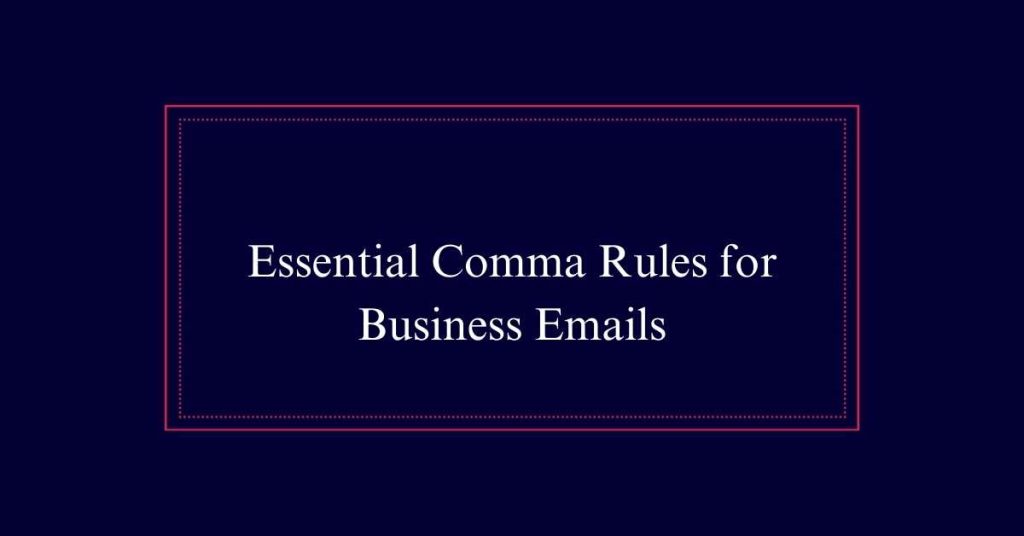Essential Comma Rules for Business Emails
Correct comma usage in business emails is essential for clear and professional communication. Use commas to separate items in a list, set off non-essential information, and create clarity after introductory elements. Formal salutations should end with a colon, while casual ones can use a comma. Misplaced commas can lead to misunderstandings and damage professional relationships. Proper punctuation avoids ambiguity and errors, enhancing the email’s readability. Always review your emails for correct comma placement to maintain professionalism.
Importance of Commas in Business
Correct comma usage is often essential in business communication. Commas help clarify the meaning of sentences. They can influence the tone and guarantee the reader understands the intended message. Proper comma placement can prevent misunderstandings and maintain professionalism.
Businesses rely on clear communication to set objectives and convey information accurately. Misplaced commas may lead to costly errors. For instance, in 1872, a misplaced comma cost taxpayers $2 million. This highlights the need for precision in business documents.
Using commas correctly reflects attention to detail. It shows that the writer values clear communication. This is critical in a business environment, where every word can impact decisions and relationships.
Impact of Misplaced Commas
Misplaced commas can lead to significant misunderstandings in business communication. A single comma can change the meaning of a sentence, leading to confusion.
For example, the phrase ‘Let’s eat, Grandpa’ is an invitation to dine together, while ‘Let’s eat Grandpa’ implies something quite different. In financial terms, misplaced commas have even led to lawsuits and large monetary losses.
Miscommunication in emails can damage professional relationships and cause errors in project execution. A famous case involved a missing comma in a contract, resulting in a $5 million court ruling.

Attention to comma placement is vital in business writing to ensure clarity and prevent costly mistakes. Always review your emails for correct punctuation before sending.
Proper Punctuation in Greetings
In business emails, the punctuation used after the salutation sets the tone for the entire message. Proper punctuation guarantees professionalism and clarity. A formal salutation should end with a colon, while a casual email can use a comma. This choice impacts how the recipient perceives the tone and formality of the email.
| Relationship | Salutation Example | Punctuation |
|---|---|---|
| Formal | Dear Mr. Smith | : |
| Formal | To Whom It May Concern | : |
| Casual | Hi John | , |
| Casual | Hello Team | , |
| Neutral | Greetings | : |
Choose the appropriate punctuation to match the relationship and context. This small detail contributes significantly to the overall professionalism of your communication.
Enhancing Clarity With Commas
Using commas correctly enhances the clarity of your business emails and guarantees your message is easily understood. Proper comma usage can make your writing clearer and more professional. It avoids confusion and ensures that your points are communicated effectively.
To enhance clarity, consider the following:
- Separate items in a list: Use commas to list items clearly.
- After introductory elements: Place a comma after introductory words or phrases.
- Before coordinating conjunctions: Use commas before conjunctions like ‘and,’ ‘but,’ or ‘or’ when they join independent clauses.
- Set off non-essential information: Use commas to set off non-essential clauses or phrases that add extra information.
Avoiding Ambiguity and Errors
Proper comma placement is essential to prevent ambiguity and errors in business communication. Misplaced commas can shift emphasis and alter the intended message. For example, ‘Let’s eat, John’ is vastly different from ‘Let’s eat John.’ Such errors can lead to confusion and misinterpretation.
Comma splices are another common error. They occur when two independent clauses are joined with a comma instead of a conjunction or semicolon. This results in run-on sentences, which make the text hard to read.
Careful attention to comma placement enhances professionalism and credibility. It guarantees that the message is clear and precise. Consistently using correct punctuation demonstrates attention to detail, which is a valuable trait in any professional setting.






